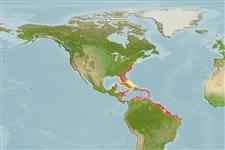>
Beloniformes (Needle fishes) >
Belonidae (Needlefishes)
Etymology: Strongylura: Greek, strongylos = round + Greek, oura = tail (Ref. 45335).
More on author: Walbaum.
Environment: milieu / climate zone / rango de profundidad / distribution range
Ecología
marino; agua dulce; salobre asociado a arrecife; rango de profundidad 0 - ? m. Subtropical; 45°N - 9°S, 88°W - 34°W
Western Atlantic: Maine, USA and northern Gulf of Mexico to Brazil. Absent from the Bahamas and Antilles (Ref. 3129).
Tamaño / Peso / Age
Madurez: Lm ? range ? - ? cm
Max length : 111 cm TL macho / no sexado; (Ref. 40637); common length : 60.0 cm TL macho / no sexado; (Ref. 5217); peso máximo publicado: 2.3 kg (Ref. 40637)
Radios blandos dorsales (total) : 14 - 17; Radios blandos anales: 16 - 20. Black pigment behind eye, not extending below level of middle of eye (Ref. 26938).
Body shape (shape guide): elongated.
Inhabits coastal areas and mangrove-lined lagoons. Enters freshwater. Feeds mainly on small fishes. Oviparous (Ref. 205). Eggs may be found attached to objects in the water by tendrils on the egg's surface (Ref. 205). Only the right gonad is developed (Ref. 26938). Marketed fresh.
Life cycle and mating behavior
Madurez | Reproducción | Puesta | Huevos | Fecundidad | Larva
Robins, C.R. and G.C. Ray, 1986. A field guide to Atlantic coast fishes of North America. Houghton Mifflin Company, Boston, U.S.A. 354 p. (Ref. 7251)
IUCN Red List Status (Ref. 130435: Version 2025-1)
Threat to humans
Harmless
Human uses
Pesquerías: escaso valor comercial; pesca deportiva: si
Herramientas
Special reports
Download XML
Fuentes de Internet
Estimates based on models
Preferred temperature (Referencia
123201): 13.3 - 28, mean 26.1 °C (based on 304 cells).
Phylogenetic diversity index (Referencia
82804): PD
50 = 0.5000 [Uniqueness, from 0.5 = low to 2.0 = high].
Bayesian length-weight: a=0.00129 (0.00079 - 0.00211), b=3.05 (2.91 - 3.19), in cm total length, based on LWR estimates for this species & Genus-body shape (Ref.
93245).
Nivel trófico (Referencia
69278): 3.0 ±0.0 se; based on diet studies.
Resiliencia (Referencia
120179): Medio, población duplicada en un tiempo mínimo de 1.4-4.4 años (Preliminary K or Fecundity.).
Fishing Vulnerability (Ref.
59153): High to very high vulnerability (67 of 100).
🛈
Nutrients (Ref.
124155): Calcium = 32.1 [9.6, 151.2] mg/100g; Iron = 0.502 [0.206, 1.149] mg/100g; Protein = 17.7 [15.6, 19.7] %; Omega3 = 0.165 [0.065, 0.473] g/100g; Selenium = 18.3 [7.7, 45.7] μg/100g; VitaminA = 51.5 [13.5, 245.1] μg/100g; Zinc = 0.78 [0.47, 1.31] mg/100g (wet weight);
